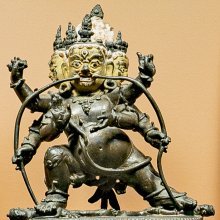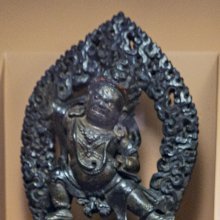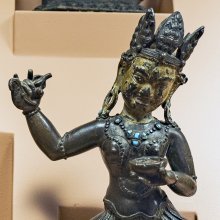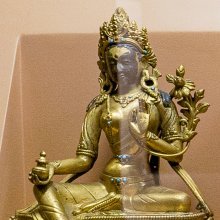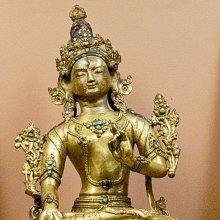Cold: 3 definitions
Introduction:
Cold means something in Hinduism, Sanskrit. If you want to know the exact meaning, history, etymology or English translation of this term then check out the descriptions on this page. Add your comment or reference to a book if you want to contribute to this summary article.
Images (photo gallery)
(+15 more images available)
In Hinduism
Yoga (school of philosophy)
Source: ORA: Amanaska (king of all yogas): A Critical Edition and Annotated Translation by Jason BirchCold (in Sanskrit: Śīta) no longer affects those students of Yoga having practices over four years, according to the Śivayogadīpikā, an ancient Sanskrit text dealing with Yoga possibly corresponding to the Śivayoga quoted in Śivānanda’s Yogacintāmaṇi.—Accordingly, [while describing a sequence of Haṭhayoga practices]: “Thus, by means of this Haṭhayoga which has eight auxiliaries, those [students who are] life-long celibates obtain the Siddhis of the [best of Sages] because of their untiring practice. [...] Then, in the third year, he is not hurt by noxious [animals] such as snakes. In the fourth year, he is free from [any] torment, thirst, sleep, cold (śīta) and heat. [...]”.

Yoga is originally considered a branch of Hindu philosophy (astika), but both ancient and modern Yoga combine the physical, mental and spiritual. Yoga teaches various physical techniques also known as āsanas (postures), used for various purposes (eg., meditation, contemplation, relaxation).
Natyashastra (theatrics and dramaturgy)
Source: Shodhganga: Elements of Art and Architecture in the Trtiyakhanda of the Visnudharmottarapurana (natya)Cold (and Danger) is associated with Kapota-hasta: one of the thirteen Combined-hand Gestures (in Indian Dramas) (known as saṃyuktahastas), according to the Viṣṇudharmottarapurāṇa, an ancient Sanskrit text which (being encyclopedic in nature) deals with a variety of cultural topics such as arts, architecture, music, grammar and astronomy.—The word kapota means pigeon in Sanskrit. When the sides of two hands are joined together it is looked like a pigeon with its wings. In the Viṣṇudharmottarapurāṇa this hand posture is called as kapotahasta and it is used to show cold and danger. But in the Abhinayadarpaṇa, this posture is said to use in salutation, addressing teachers, polite acceptance or agreement.

Natyashastra (नाट्यशास्त्र, nāṭyaśāstra) refers to both the ancient Indian tradition (shastra) of performing arts, (natya—theatrics, drama, dance, music), as well as the name of a Sanskrit work dealing with these subjects. It also teaches the rules for composing Dramatic plays (nataka), construction and performance of Theater, and Poetic works (kavya).
Kavyashastra (science of poetry)
Source: Shodhganga: Elements of Art and Architecture in the Trtiyakhanda of the Visnudharmottarapurana (kavya)The Cold Season is beautifully portrayed in the Ṛtusaṃhāra of Kālidāsa.—Accordingly, in the cold season, the earth is filled with clusters of grown-up rice and sugar cane.

Kavyashastra (काव्यशास्त्र, kāvyaśāstra) refers to the ancient Indian tradition of poetry (kavya). Canonical literature (shastra) of the includes encyclopedic manuals dealing with prosody, rhetoric and various other guidelines serving to teach the poet how to compose literature.
See also (Relevant definitions)
Starts with: Cold mountain crazyweed, Cold-desert phlox, Coldenia procumbens.
Full-text (+1675): Hima, Sita, Shitala, Shishira, Saitya, Himya, Pinasa, Shitoshna, Hemanta, Tushara, Sitaka, Shitakala, Shitalu, Susima, Himelu, Haima, Shitata, Jada, Himagama, Himasaras.
Relevant text
Search found 330 books and stories containing Cold; (plurals include: Colds). You can also click to the full overview containing English textual excerpts. Below are direct links for the most relevant articles:
The Catu-Bhanavara-Pali (critical study) (by Moumita Dutta Banik)
(4) Girimananda Sutta < [Chapter 3 - Subject Matter of the Second Bhanavara]
(5) The Paccavekkhana < [Chapter 2 - Subject Matter of the First Bhanavara]
(5) Isigili Sutta < [Chapter 3 - Subject Matter of the Second Bhanavara]
Vinaya Pitaka (3): Khandhaka (by I. B. Horner)
Allowance for three robes < [8. Robes (Cīvara)]
Allowance to enter the rains < [3. Rains (Vassa)]
On Mucalinda < [1. Going forth (Pabbajjā)]
Maha Prajnaparamita Sastra (by Gelongma Karma Migme Chödrön)
The sixteen utsadas annexed to the eight great hells < [The world of transmigration]
The eight cold hells < [The world of transmigration]
Appendix 2 - Episode of Hastaka of Āḷavi < [Chapter XLII - The Great Loving-kindness and the Great Compassion of the Buddhas]
The Jataka tales [English], Volume 1-6 (by Robert Chalmers)
Jataka 17: Māluta-jātaka < [Book I - Ekanipāta]
Jataka 237: Sāketa-jātaka < [Book II - Dukanipāta]
Jataka 250: Kapi-jātaka < [Book II - Dukanipāta]
Tattvartha Sutra (with commentary) (by Vijay K. Jain)
Verse 2.32 - The kinds of seats-of-birth (yoni) < [Chapter 2 - Category of the Living]
Verse 3.3 - Infernal beings (nārakī) < [Chapter 3 - The Lower World and the Middle World]
Verse 9.16 - The afflictions caused by the feeling karmas < [Chapter 9 - Stoppage and Shedding of Karmas]
Apadana commentary (Atthakatha) (by U Lu Pe Win)
Commentary on the stanza on sīta-āluka (susceptible to cold) < [Commentary on biography of Silent Buddhas (Paccekabuddha)]
Commentary on the stanza on future danger (āyati-bhaya) < [Commentary on biography of Silent Buddhas (Paccekabuddha)]
Commentary on Biography of the thera Lasuṇadāyaka < [Chapter 4 - Kuṇḍadhānavagga (section on Kuṇḍadhāna)]
Related products
(+136 more products available)

